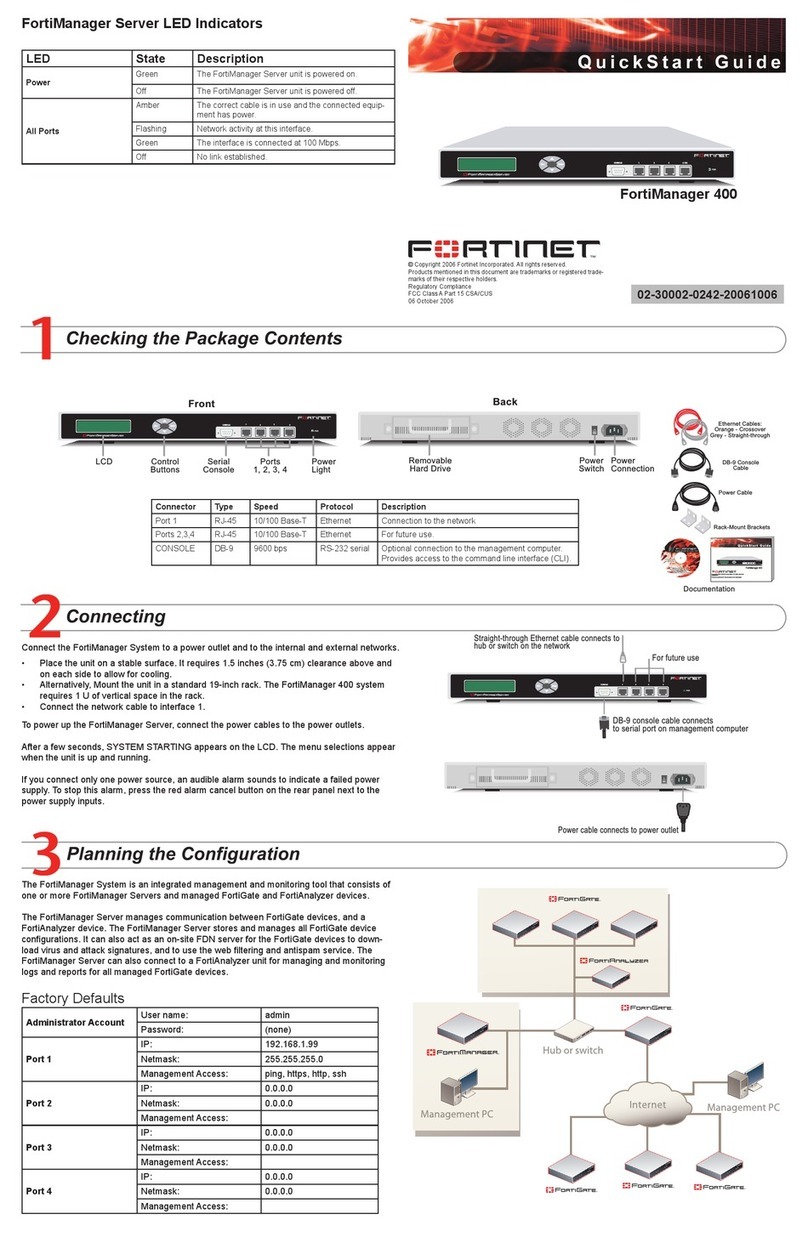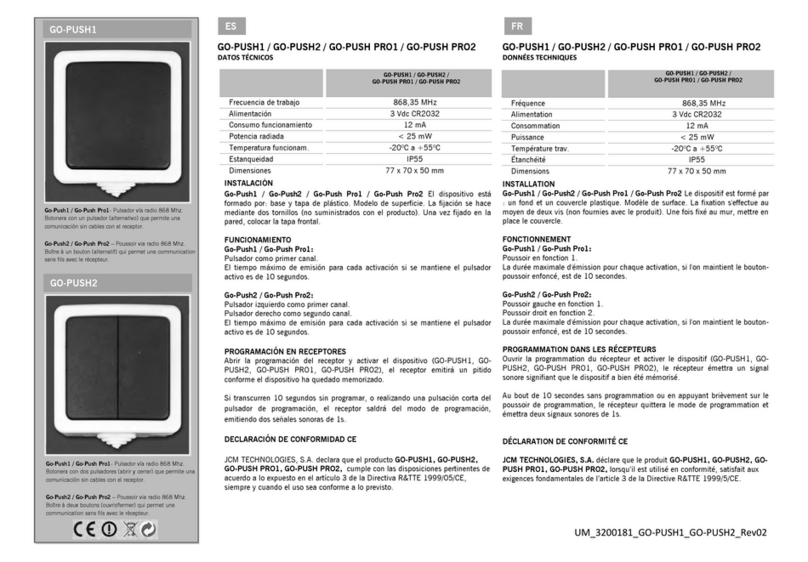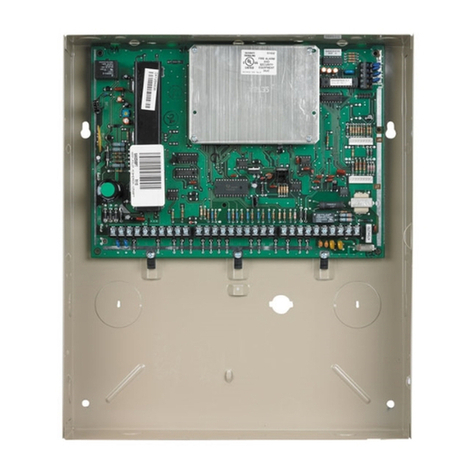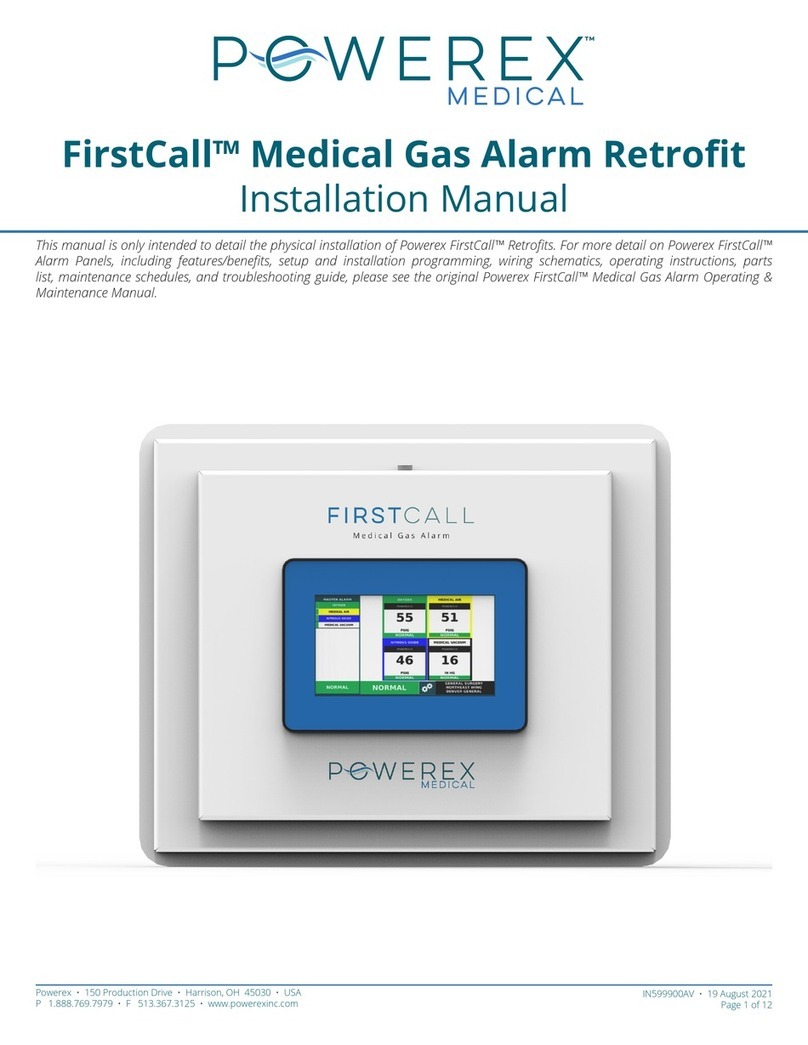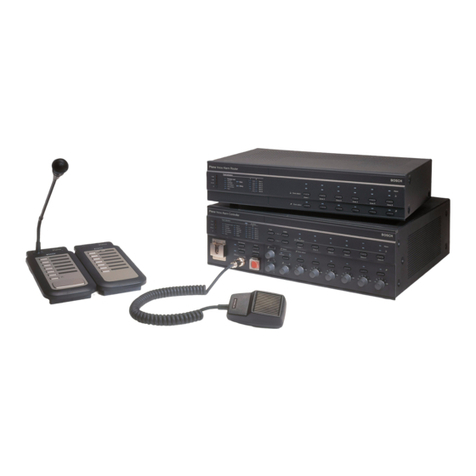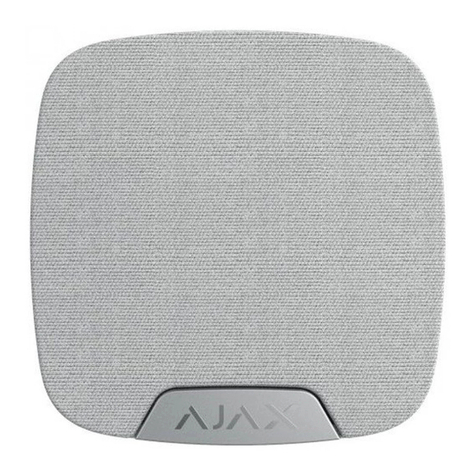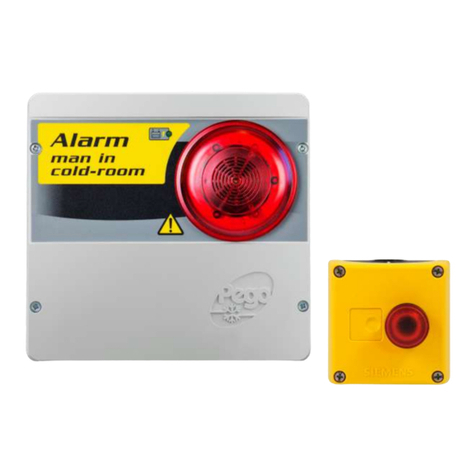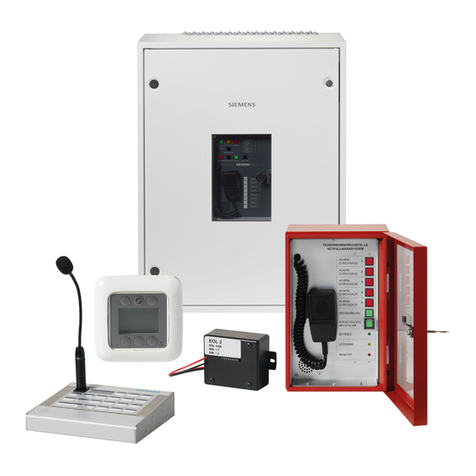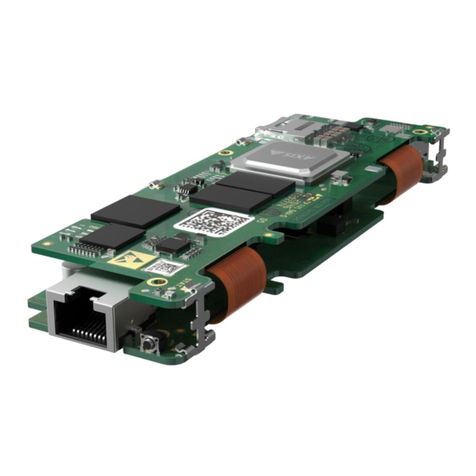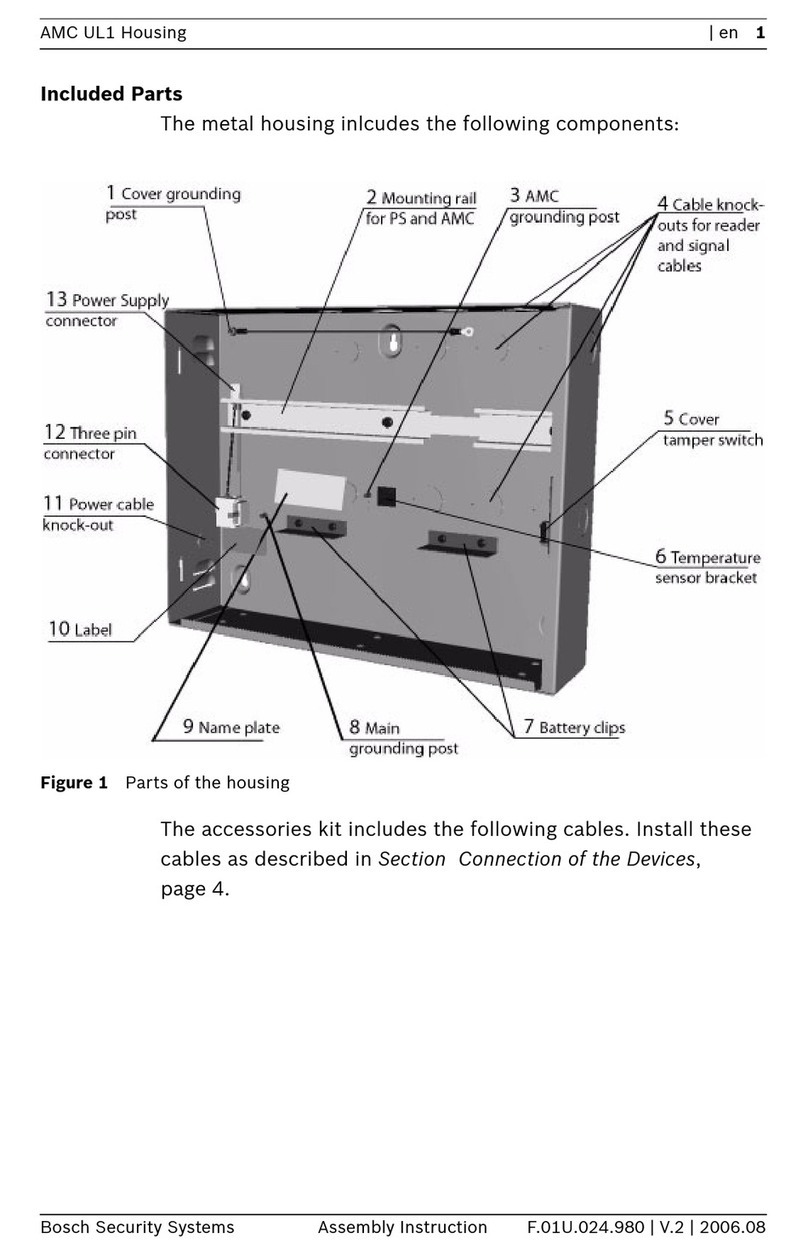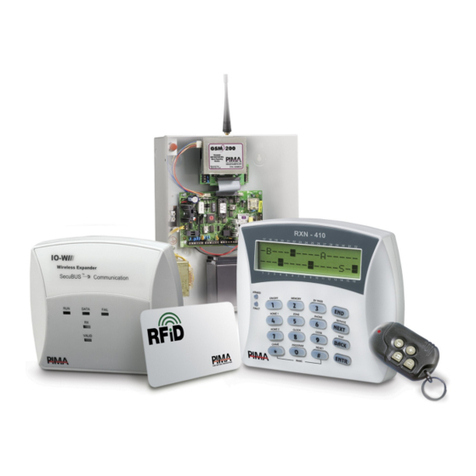Fire Burglary Instruments OMNI-848 Manual

6HFXULW\6\VWHP
2
20
01
1,
,
2
20
01
1,
,
(
(8
8
,QVWDOODWLRQDQG6HWXS*XLGH
ARMED
READY
1
4
7
2
5
8
0
3
6
9
#
STAY
BYPASS
INSTANT
CODE
ARMED
READY
1
4
7
2
5
8
0
3
6
9
#
STAY
BYPASS
INSTANT
CODE
1 3
2
4 6
5
7 9
8
#
0
STAY INSTANT
BYPASS CODE
ARM
AC / LB
READY
STAY
INST
LO BATT
SPRV.
N9938V1 4/01

ii
THANK YOU for your purchase of the
OMNI®-848 Security System.
The purpose of this manual is to give you a brief overview of the OMNI-848 control panel, and provide
instructions for installing a basic system. FBII is always available to serve YOU. Our SALES and
TECHNICAL SUPPORT staff are available to assist you in every way possible.
World Wide Web Address ......................................................... HTTP://WWW.FBII.COM
FAX ................................................................................................................516-921-4327
Sales
Inside the United States ............................................................................800-645-5430
Outside the United States..........................................................................516-921-8666
Technical Support: (8 a.m.-8 p.m. E.S.T.)
Inside the United States ............................................................................800-645-7492
Outside the United States..........................................................................516-921-8666
Before you call Technical Service, PLEASE be sure you:
• Check the wiring diagram and verify your connections.
• Check all fuses.
• Ensure that the transformer and backup battery voltages are supplying the proper voltage levels.
• Verify your programming information.
• Read this manual thoroughly.
• Consult the Troubleshooting Section of this manual.
• Note the proper model number of this product, and the version level (if known), along with any
documentation that came with the product.
• Have your company name and telephone number ready.
This information will allow us to serve you more quickly and effectively. Please, remember to BE PATIENT
while waiting on the telephone; your call will be answered as soon as possible.
FOR YOUR CONVENIENCE, a separate Programming Guide is included with this manual. It provides
space for listing entries for each programming question.

iii
7DEOHRI&RQWHQWV
•••••••••••••••••••••••••••••••••••••••••••••••••
Section 1 – Introduction ........................................................................................................ 1-1
System Features................................................................................................................................... 1-1
Special Notes......................................................................................................................................... 1-2
Section 2 – System Wiring and Hookup............................................................................. 2-1
System Wiring Diagram....................................................................................................................... 2-1
Terminal Connections .......................................................................................................................... 2-2
Auxiliary Device Current Draw Worksheet........................................................................................ 2-5
Wiring Information for Keypads & Other Devices.............................................................................. 2-5
Keypad Addressing............................................................................................................................... 2-6
Section 3 – PC Board Mounting........................................................................................... 3-1
Mounting the OMNI-848/OMNI-848EU PC Board............................................................................. 3-1
Mounting the RF Expander Module.................................................................................................... 3-2
Mounting the Zone Expander Module................................................................................................. 3-2
Section 4 – System Configurations ..................................................................................... 4-1
Partitioning........................................................................................................................................... 4-1
Hardwire Zones and Zone Expansion Module..................................................................................... 4-2
Relay/Trigger Outputs.......................................................................................................................... 4-3
Wireless Transmitters.......................................................................................................................... 4-4
Paging/Beeps (Audio Tone Format)..................................................................................................... 4-4
Section 5 – System Operations............................................................................................. 5-1
Power-Up/System Reset....................................................................................................................... 5-1
Keypads................................................................................................................................................. 5-1
Keypad Sounder.................................................................................................................................... 5-3
Keypad Backlight Timer ...................................................................................................................... 5-4
Arming the System............................................................................................................................... 5-4
User Code Programming...................................................................................................................... 5-6
User Deletion........................................................................................................................................ 5-8
Special Keypad Functions.................................................................................................................... 5-8
Quick Command Modes........................................................................................................................ 5-8
Section 6 – System Programming........................................................................................ 6-1
System Default ..................................................................................................................................... 6-1
Keypad Programming........................................................................................................................... 6-1
Installer Modes Summary.................................................................................................................... 6-5
Data Entry Via Keypads...................................................................................................................... 6-8
Summary of System Programming.................................................................................................... 6-10
Installer Mode 1, Submode 1: SYSTEM OPTIONS .......................................................................... 6-10
Submode 2: ZONE PROGRAMMING / REPORT CODES................................................................ 6-39
Submode 3: WIRELESS TRANSMITTER PROGRAMMING.......................................................... 6-44
Submode 4: DESCRIPTOR PROGRAMMING.................................................................................. 6-45
Section 7 – Summary of Keypad Functions ...................................................................... 7-1
User Functions...................................................................................................................................... 7-1
Installer Modes..................................................................................................................................... 7-2
Section 8 – Central Station Reporting Formats .............................................................. 8-1
Standard (3x1 or 4x1)........................................................................................................................... 8-1
Extended (3x1 Ext. or 4x1 Ext.)........................................................................................................... 8-2
Partial Extended (3x1 Part. Ext. or 4x1 Part. Ext.)............................................................................ 8-2
3x2 or 4x2.............................................................................................................................................. 8-2
FBII Superfast (4x3x1)......................................................................................................................... 8-3
ADEMCO 4x1 Express......................................................................................................................... 8-3
ADEMCO 4x2 Express......................................................................................................................... 8-3
ADEMCO Point ID............................................................................................................................... 8-4
Section 9 – Troubleshooting ................................................................................................. 9-1
Section 10 – Regulatory/Limitations Statements.......................................................... 10-1

iv
&RQYHQWLRQV8VHGLQ7KLV0DQXDO
•••••••••••••••••••••••••••••••••••••••••••••••••
Before you begin using this manual, it is important that you understand the meaning of the
following symbols (icons) and text note.
ULThese notes include specific information that must be followed if you are installing this system for
a UL Listed application.
These notes include information that you should be aware of before continuing with the
installation, and which, if not observed, could result in operational difficulties.
!
This symbol indicates a critical note that could seriously affect the operation of the system, or
could cause damage to the system. Please read each warning carefully. This symbol also alerts
the user to the possibility of physical harm if instructions are not followed as written
.
NOTE:
These text notes are provided throughout the manual to provide informative information and
shortcut tips for the installer.

1-1
SECTION 1
,QWURGXFWLRQ
•••••••••••••••••••••••••••••••••••••••••••••••••
System Features
The OMNI®-848 and OMNI®-848EU are state-of-the-art microprocessor-based controls/
communicators that provide 3 partitions plus a common partition, and support both hardwire
and wireless zones. Programming can be performed through any of the compatible keypads;
or the system can be uploaded and downloaded remotely using the Compass Downloader
Software. Additionally, the software can be programmed to control remote actions, such as
arming, disarming, bypassing, etc. Programming options are stored in an Electrically
Erasable Programmable Read-Only Memory (EEPROM). The EEPROM is nonvolatile,
meaning that programmed instructions will not be lost in the event of a loss of power.
Features of the OMNI-848 and OMNI-848EU include:
• 4 partitions: 3 independent partitions plus a
common partition
• 8 hardwire zones (all fully programmable,
including keyswitch), expandable to 8
additional hardwire zones using optional plug-
in OMNI-EXP8 Expansion Module
• Hardwire zones can be configured as standard
end of line (EOL), normally closed, or normally
open
• 48 wireless protection zones plus up to 8
wireless keys
• Cross zoning capability
• 64 user codes (either 4-digit or 6-digit codes
can be used)
• Up to 12 keypads (OMNI-LCD, XK-7LC,
OMNI-KP)
XK-108 keypads may also be used; however,
the system can only have XK-108 type
keypads attached and the system must be set
up as having one partition.
• Keypad programming and remote
programming via PC and modem
• Upload/download and remote commands
• 3 methods of uploading/downloading: PC
operator-initiated, unattended downloading,
and on-line downloading
• Paging (audio format) capabilities
• Auto Arming at a specific time of day with
capability to arm in either Away, Stay, or
Instant modes
• Two entry timers
• 128-event history log (alarms, troubles, low
battery, bypasses, control station (cs) test,
openings, and closings) and keypad events
• 3 emergency keypad conditions (panic, fire,
and auxiliary)
• 4 built-in programmable trigger outputs
• Real-time clock (displays time and date via
LCD keypad) with reminder when clock needs
to be set
• CS test timer by event, time, or both (1 hour, 1,
7, 27, 60, 90 days)
• Customer control of chime mode and pager
mode
• Quick arming, quick bypass, and quick force
arming
• CS reporting by zone
• False alarm prevention features: crossed
zones, exit error, recent close, swinger
shutdown
• Cancel code and system stabilization during
power-up
• Arming by keyswitch in Away or Stay mode
• Keypad tamper/lockout with optional CS
reporting
• Restore transmission options: after loop or
after bell
• Fire zone reset through keypad
• Glassbreak reset through keypad
• Bell Test, Low Battery Test, AC Loss and
Communications Failure indications
• Input power: 16.5VAC, 25VA; 12VDC, 4-7AH
• Output power: 12VDC, 500mA
• Bell output power: 12VDC, 1A

OMNI-848/OMNI-848EU Installation and Setup Guide
1-2
Special Notes
UL
IMPORTANT - Failure to install and program this unit in accordance with the UL require-
ment is a violation of the listing mark. For more information on UL Listings, contact
Underwriters Laboratories, Progress Department, 333 Pfingsten Road, Northbrook IL
60062.
UL Listings
The OMNI-848 is the Residential (Household) version of the control panel, and has been
Listed by Underwriters Laboratories for the following applications:
• UL 1023 Household Burglary
• UL 985 Household Fire Warning
FCC Registration Number: 5GBUSA-44003-AL-E
REN: 0.1B
The OMNI-848EU has not been evaluated by Underwriters Laboratories.
References to Programming Questions
Programming questions are grouped into 4 installer programming submodes, as follows:
1 –System Options
2 –Zone and Report Code Programming
3 –Wireless Zone/Keyfob Programming
4 –Zone Descriptor Programming
Throughout this manual, programming question references without a submode designation
pertain to questions in submode 1 (system options). Programming questions for other
submodes include the appropriate submode number.

2-1
SECTION 2
6\VWHP:LULQJDQG+RRNXS
•••••••••••••••••••••••••••••••••••••••••••••••••
System Wiring Diagram
OMNI848-SOC-V1
1 2 3 4 5 6 7 8 9 10 11 12 13 14 15 16 17 18 19 20 21 22 23 24 25 26 27 28
CONNECT GROUNDING LUGS TO LEFT-HAND TERMINALS
DIRECT PLUG-IN RECEIVER
INTERNAL
CONNECTIONS
SMOKE POWER (6+) & (7-)
12VDC REG., 50mA MAX
++
+
-
-
BELL
OR
2.2k
ZONE
1
2.2k
ZONE
2
2.2k
ZONE
3
2.2k
ZONE
4
2.2k
ZONE
5
2.2k
ZONE
6
2.2k
ZONE
7
2.2k
ZONE
8
BLACK ( )
YELLOW (DATA IN)
GREEN (DATA OUT)
RED (+)
MODEL 368 CORD
TO RJ31X OR
CA38A JACK
TELCO
HOME
+
_
JP1 JP2
29 30 31 32 33 34 35 36 37 38 39 40
P2 P3
2.2k
ZONE
9
2.2k
ZONE
10
2.2k
ZONE
11
2.2k
ZONE
12
2.2k
ZONE
13
2.2k
ZONE
14
2.2k
ZONE
15
2.2k
ZONE
16
TRIGGERS
+VBELL
GROUND
TRIGGER 2
TRIGGER 3 (OR CLOCK)
*
TRIGGER 4 (OR DATA)
*
TRIGGER 1
OMNIEXP 8
HARDWIRE ZONE EXPANDER
(optional)
*
IF XL4705 RELAY
MODULES USED.
RED
GREEN
GRAY
BROWN
AUX PWR
(500mA MAX)
P3
P2
PROGRAMMING
DEFAULT JUMPERS
EXT. SIREN SUPERVISION INPUT
OPTIONAL
TRIGGER CABLE
XL4612TC
TYPICAL DOUBLE
BALANCED ZONES
TYPICAL CONNECTION
FOR ZONE DOUBLING
JP4 JUMPER
PINS
APPLICATION
1 & 2
2 & 3
STANDARD BELL
SUPERVISION
EXTERNAL SIREN
DRIVER SUPERVISION
(USE TERM. 6 FOR
SVSN. INPUT)
7.5k
ZONE 2
3.3k
ZONE 1
2.2k
2.2k
2.2k
2.2k
2.2k
2.2k
TAMPER
CONTACTS
TAMPER
CONTACTS
TELCO CONNECTOR
(APPLICABLE ONLY
IN AUSTRALIA)
FIRE &
BURGLARY
ALARM
OUTPUT
(11.5 -
13.1VDC,
1A MAX)
STANDARD EOLR
ZR-401/ZR-402EU/OMNI-RF
RF RECEIVER
(optional)
EARTH
GROUND
TRANSFORMER
16.5 VAC, 25VA
(CONNECT TO 24 HR.
AC OUTLET)
TO PREVENT RISK FROM ELECTRICAL
SHOCK, DE-ENERGIZE THE SYSTEM
CONTROL UNIT AND DISCONNECT THE
TELEPHONE LINES BEFORE SERVICING
THIS UNIT.
WARNING
CONNECT TRIGGER OUTPUTS
TO DEVICES RATED FROM
10.1-14.OVDC AT 50mA.
BELL
SUPV
JP4
12V, 4-6H
BATTERY
MODEL 467
BLACK
RED
NOTES
1. FOR UL INSTALLATIONS, USE TWO 4 AH
BATTERIES CONNECTED IN PARALLEL FOR
MINIMUM STANDBY TIME OF 24 HOURS.
THE TWO BATTERY CABLE (P/N F344)
IS OPTIONAL AND NOT INCLUDED WITH
THE PANEL.
2. 180mA MAX. AUX. POWER (INCLUDING
KEYPADS CONNECTED TO TERMINALS 23-25)
FOR UL INSTALLATIONS.
3. 650mA MAX. ALARM OUTPUT FOR
UL INSTALLATIONS.
4. FOR CE COMPLIANCE, WIRE THE OMNI-EXP8
EXPANDER AS DESCRIBED IN THE OMNI-EXP8
INSTALLATION AND SETUP GUIDE, N9953V1
OR HIGHER.
98 98 10
SELF-CONTAINED
SIREN
ANTENNA 1 ANTENNA 2
USE WITH XK108 OR
OMNI-LCD, XK-7LC,
AND OMNI-KP
IMPORTANT: All control panel wiring should be completed prior to applying power to avoid possible
harm to circuits due to electrostatic discharge.
SYSTEM STABILIZATION MODE: When powering up a system that was previously armed when power was
removed, the system will enter a 2-minute stabilization period. This 2-minute interval is used to allow
motion detectors to stabilize. “PLEASE STAND BY”and “POWER UP DELAY”are displayed on the
OMNI-LCD and XK-7LC keypads. “PL”is displayed on the OMNI-KP keypad, and the Armed LEDs on
both keypads are lit. All LEDs on the XK-108 keypad are lit.

OMNI-848/OMNI-848EU Installation and Setup Guide
2-2
Terminal Connections
TERMINALS DESCRIPTION
1 & 2 TRANSFORMER:
For the OMNI-848, connect the 16.5VAC 25VA transformer, utilizing
18awg or larger wire at a distance not to exceed 15 feet from the panel, to
an unswitched 120VAC outlet.
NOTE: A 16.5VAC 25VA transformer is required for the OMNI-848EU,
but it is not supplied. Check transformer documentation, and connect the
transformer to a compatible AC power source.
The system can supply up to 1.8 amps of total current.
The “AC/LOW BAT”keypad LED remains ON while AC power is present.
If an AC loss occurs, the “AC/LOW BAT”LED turns off immediately. If
AC power remains OFF for 15 minutes, the system pulses the keypad
buzzer and transmits a power-loss message to the central station, if
programmed to do so. The keypad buzzer can be silenced by entry of any
valid user code. When AC restores, the “AC/LOW BAT”LED lights
immediately, and a Restore code is reported, if programmed.
3(+) & 4(-) BELL OUTPUT:
The total output power available for sounding devices is 1 amp at 11.5 -
13.1VDC. Bell output max. 650mA for UL Installations. These terminals
will deliver constant output on burglary, audible panic, and bell test. On
a fire condition, a pulsed or temporal output can be generated. There are
separate bell cutoff times programmable for burglary and fire conditions
within the programming sequence. For Household Fire Warning System
installations, the speaker must be mounted indoors for best audibility.
Also, for UL installations, use only one bell.
NOTE: Before connecting sounding devices, please consult the
specifications for proper current draw.
NFPA 72 REQUIREMENT: All the
interconnecting pathways (cable, wire,
etc.) between the alarm system initiating
device (control panel) and the signaling
device (bell, speaker, siren, etc.) shall
be monitored for an occurrence of an
open circuit, which prevents the normal
operation of the system. An occurrence
of an open circuit shall be indicated by a
distinctive trouble signal.
BELL SUPERVISION (Bell ) - To meet the NFPA 72 requirement, program
Question 17, Location 3, in Submode 1 for bell supervision. The bell is
then supervised for an open circuit (not a short circuit) across the bell
output terminals; the keypad will indicate that a fire trouble condition
has occurred and fire trouble is reported to the CS if enabled. If the bell
is already ringing, the supervision will not take effect until after bell
cutoff time.
SIREN SUPERVISION (Self-Contained Siren/Speaker)
(Not for use in UL installations.) To meet the NFPA 72 requirement,
program Question 17, Location 3, in Submode 1 for bell supervision. The
siren is then supervised for an open circuit (not a short circuit) across the
bell output terminals; the keypad will indicate that a supervision
condition has occurred and bell supervision is reported to the CS if
enabled (program mode 2, Question 79, Locations 1,2). If the siren is
already sounding, the supervision will not take effect until after bell
cutoff time.
NOTE: Use FBII models ZR-815C, ZR-815EC, or ZR-830EC.

Section 2: System Wiring and Hookup
2-3
5 SIREN SUPERVISION INPUT:
The bell output may be supervised when a conventional bell or a
self-contained siren is connected. When you connect a conventional bell or
a self-contained siren to the bell output terminals (3 and 4), place the
jumper JP4 across pins 1 and 2. When you connect an external siren
driver to the bell output terminals, connect the supervision wire to the
siren supervision terminal of the siren driver, and place the jumper JP4
across pins 2 and 3. A supervisory condition will generate a pulsing
keypad sounder. Also, the supervisory LED on the keypad will pulse. The
sounder may be silenced by entering a valid user code while the system is
disarmed. The LED will continue to pulse until the supervision is fixed. If
a bell, self-contained siren, or external siren driver is not connected to the
bell output terminals, a 100-ohm resistor must be placed across the siren
supervision input to prevent a bell supervision error, or you must disable
bell supervision (Programming Question 17, Location 3). Bell supervision
will be reported to the CS if CS code is enabled.
6(+) & 7(–) SMOKE DETECTOR POWER:
B+ This system accepts 9.5 - 12VDC 4-wire smoke detectors only.
Approximately 50mA of current is available at these terminals for
powering all detectors. These terminals adhere to the fire verification
and reset logic, which is explained in the zone types section of this
manual. For UL installations, use a UL Listed smoke detector.
6(+) & 4(-) REGULATED POWER (11.5 - 13.1VDC):
B+ The total regulated output power for motion detectors and other external
devices is 500mA at 11.8 - 12.5V for residential applications, or 12.0 -
12.5V for commercial applications, with less than 100 mVPP ripple. The
total regulated output capacity of the OMNI-848 includes the power
available from these terminals (6 and 4) as well as the power used by the
keypads (23 [+] and 20 [–]) and smoke detectors (7 [–] and 6 [+]).
Therefore, to determine the total power available from these terminals,
subtract the power consumed by the keypads and smoke detectors. The
maximum auxiliary output for UL installations is 180mA.
ZONE INFORMATION (HARDWIRED ZONES):
8(+) & 9(-) Zone 1 [Default = DELAY]
10(+) & 9(-) Zone 2 [Default = INTERIOR]
11(+) & 12(-) Zone 3 [Default = INSTANT]
13(+) & 12(-) Zone 4 [Default = INSTANT]
14(+) & 15(-) Zone 5 [Default = INSTANT]
16(+) & 15(-) Zone 6 [Default = INSTANT]
17(+) & 18(-) Zone 7 [Default = INSTANT]
19(+) & 18(-) Zone 8 [Default = INSTANT]
Normally-closed devices may be wired in series; normally-open devices
may be wired in parallel. A 2.2k-ohm end-of-line resistor can be installed
on all zones. (Refer to the wiring diagram.) The standard loop response
time is 280ms on all zones. The factory default values for each zone are
listed in the table above; however, any zone can be programmed for the
following types: Delay, Perimeter, Interior, Fire, 24-Hr. Alarm, or 24-Hr.
Trouble. Further explanation of the zone types can be found in the
System Programming section of this manual.
NOTE: Loop response is defined as the minimum time required for a fault
to trip a zone.

OMNI-848/OMNI-848EU Installation and Setup Guide
2-4
ZONE INFORMATION (WIRELESS ZONES):
RF RECEIVER Up to 48 wireless zones can be used if the ZR-401, ZR-402EU, or OMNI-
RF Wireless Expansion Module is installed. The maximum number of
zones (48) includes the 8 basic wired zones, wired zones using the
expansion module, and the wireless zones. Compatible ADEMCO 5800
Series wireless devices must be used. See the “Wireless Zones”paragraph
in the System Configuration section for more information on using
wireless zones and for a list of compatible transmitters. The ZR-402EU
and OMNI-RF Wireless Expansion Modules have not been evaluated by
UL.
20(BLK), 21(YEL)
22(GREEN) &
23(RED)
KEYPADS:
Up to 12 keypads (OMNI-KP, OMNI-LCD, XK-7LC, or XK-108), but no
more than eight of any one type, may be wired to these terminals. The
connections are as follows: 20 (BLACK = negative), 21 (YELLOW = data
in), 22 (GREEN = data out), and 23 (RED = positive power). Refer to
table in the “Auxiliary Device Current Draw Worksheet”paragraph of
this section to obtain keypad current draw information.
NOTE: In some installations, it may be necessary to use shielded wire to
prevent radio frequency interference.
24 EARTH GROUND:
Connect this grounding lug to a cold water pipe utilizing #18awg (1mm)
wire at a distance of no greater than 15 ft. Use a noncorrosive metal
strap firmly secured to the pipe to which the lead is electrically
connected and secured. If the premises pipes terminate in PVC, this
terminal must be connected to a 6-foot grounding rod.
25(BRN), 26(GRAY),
27(GREEN) &
28(RED)
TELEPHONE LINE:
Connect the RJ31X cord as follows: 25 (BROWN = Home Tip), 26 (GRAY
= Home Ring), 27 (GREEN = Telco Tip), 28 (RED = Telco Ring). Insert
the plug into an USOCRJ31X Jack (or a CA31A Jack for Canadian
installations).
The FCC registration number is 5GBUSA-44003-AL-E, and the ringer
equivalence is 0.1B. The system should not be connected to party lines or
coin-operated phones.
If this control panel will be used for uploading, downloading, or remote-
command applications, the telephone line connected to the control panel
must not be shared with a fax machine or modem. Furthermore, this
device should not be connected to a phone line that has Call Waiting,
unless the Call Waiting Interrupt numbers are programmed into the
panel dialing sequence.
BACKUP BATTERY: The RED (+) and BLACK (-) flying leads must be connected to a 12VDC
4-7AH battery to serve as backup power in the event of AC loss.
A battery test occurs approximately every minute. Low-battery condition
occurs at nominal 11VDC. The keypad AC/LOW BAT LED and buzzer
pulse slowly when a low-battery condition is detected. The system reports
this condition to the CS if programmed to do so. There is also an option
that prevents the system from arming if a low battery has been detected
(see Question 19, L2). Battery restore will occur within 4 minutes, at the
next battery test. The buzzer may be silenced by entering any valid user
code.
NOTE: For UL installations, use two 4AH batteries connected in parallel.

Section 2: System Wiring and Hookup
2-5
TRIGGER OUTPUTS: The control panel has four built-in programmable trigger outputs. See
programming questions 47-48 for valid trigger types and programming.
NOTE: In order to connect devices to the triggers, use connector
XL4612TC (trigger cable). Connect to terminal P1 VBELL to obtain a
POSITIVE reference point.Triggers 1, 2, 3, and 4 will go to a negative
ground potential when active. For UL installations, the trigger outputs
shall be connected to devices rated to operate over the range from 10.1 -
14.0VDC at 50mA.
Auxiliary Device Current Draw Worksheet
DEVICE
CURRENT DRAW
FOR EACH
NUMBER
OF UNITS
TOTAL CURRENT
FOR EACH
Control Panel 65mA
OMNI-LCD (Backlight Off/On) 35mA/81mA
XK-7LC 65mA
OMNI-KP (Backlight Off/On) 28mA/45mA
XK-108 5mA
PIR **
Smoke Detector **
Glass Break Detector **
**
**
TOTAL CURRENT FOR ALL DEVICES =
(500mA max.)
** If you are using devices such as PIR’s, smoke detectors, etc., refer to the specifications for
that particular device's current draw. If the total current draw exceeds 500mA, use an
additional power supply.
NOTE: For UL installations, do not exceed 180mA.
NFPA, UL, and the California State Fire Marshal require the backup battery to provide power for
24 hours. The maximum aux. power varies by the ampere/hour rating of the battery used:
5AH = 95mA; 7AH = 180mA; 8AH = 210mA.
Wiring Information for Keypads & Other Devices
If single or multiple devices are connected to a single 4-wire or 2-wire run ("daisy-chained")
to the control terminals, determine the current drawn by the unit(s) connected to the single
wire run, then refer to the Wiring Run Table below to determine the maximum wire length
that can be safely used for each wire size.
In some cases, the total current drawn may result in a value not shown in the table. For
example, if you plan to use #22 gauge (0.64mm) wire and the total current drawn is 400mA
(a value between 300mA and 500mA), the maximum wire length you should use is
approximately 65 ft or 20 m (a length between 50 and 80 ft or 15 and 24 m). Other maximum
wire lengths for values of current not shown in the table can be calculated in a similar
manner.

OMNI-848/OMNI-848EU Installation and Setup Guide
2-6
Maximum wire lengths for a device that is "home run" to the control can also be determined
from the table, based on the current draw of that device alone.
Wiring Run Table for Devices Drawing Power From Terminals 23 (+) & 20 (-)
TOTAL CURRENT DRAWN BY ALL UNITS ON A SINGLE WIRE RUN
WIRE SIZE 50mA or less 100mA 300mA 500mA
#22 500 ft. (152 m.) 250 ft. (76 m.) 80 ft. (24 m.) 50 ft. (15 m.)
#20 750 ft. (228.6 m.) 380 ft. (116 m.) 130 ft. (39.6 m.) 80 ft. (24 m.)
#18 1300 ft. (396 m.) 650 ft. (198 m.) 220 ft. (67 m.) 130 ft. (39.6 m.)
#16 2000 ft. (609.6 m.) 1000 ft. (305 m.) 330 ft. (100.5 m.) 200 ft. (70 m.)
Examples:
1. What is the maximum distance from the control panel for one keypad drawing 30mA
using #20 gauge (0.8mm) wire?
Using the table, the keypad can be placed no further than 750 ft. (230 m) away from the
panel (50mA or less).
2. What is the maximum distance for 3 keypads drawing 150mA using #20 gauge (0.8mm)
wire connected in a single wire run?
Using the tables above, the farthest keypad can be placed no more than 317.5 ft. away from the
panel. (380-130=250; 250÷2=125; 130+125=255 ft for 200mA; then 380-255=125; 125÷2=62.5;
62.5+255=317.5 ft.
3. What is the maximum distance for 5 smoke detectors drawing 0.25mA (50µA each) using
#22 gauge (0.64mm) wire connected in a single wire run?
Using the table, the farthest smoke detector can be placed no more than 500 ft. (152m) away from
the panel.
Keypad Addressing
The keypad address identifies the keypad number to the control panel as programmed in
Questions 49-52. Fixed-word and LCD keypads can share the same addresses (e.g., you can
have fixed-word keypad address 1 and LCD keypad address 1).
Set the OMNI-KP and OMNI-LCD keypad addresses by following the steps below (refer
to the instructions provided with the keypads for additional information on setting the
keypad addresses):
1. Within 30 seconds after applying power to the unit, press the [Code] and [Stay] keys at
the same time and hold them for several seconds.
2. When the display shows a pulsing single digit, enter the address 1-8.
3. To terminate the mode, press [∗].
Switch
Address 1 2 3
01 off off off
02 ON off off
03 off ON off
04 ON ON off
05 off off ON
06 ON off ON
07 off ON ON
Set the XK-7LC keypad address by using its DIP
switches:
Refer to the instructions provided with the keypad for
additional information on setting the keypad address.
08 ON ON ON
NOTE: The XK-108 keypad may also be used on the system; however, when using the XK-
108, keypad addressing does not apply. Additionally, you can not use any other type of
keypad if using XK-108’s on the system.

3-1
SECTION 3
3&%RDUG0RXQWLQJ
•••••••••••••••••••••••••••••••••••••••••••••••••
Mounting the OMNI-848/OMNI-848EU PC Board
NOTE: The door of the metal cabinet may be removed to make it easier to install the control
panel.
Remove the door as follows:
1. With the cabinet lying on a flat surface, swing open the door to its full open position.
2. Slide the door out of its retaining slots in the cabinet and store in a safe place.
BEFORE MOUNTING PRINTED CIRCUIT BOARD, BE CERTAIN THAT
APPROPRIATE METAL KNOCKOUTS HAVE BEEN REMOVED FROM THE
METAL CABINET. DO NOT ATTEMPT TO REMOVE THE KNOCKOUTS AFTER
CIRCUIT BOARD HAS BEEN INSTALLED.
Mount the circuit board as follows:
1. Hang three mounting clips on the raised cabinet tabs. Observe proper clip orientation to
avoid damage to clip when mounting screws are tightened and to avoid problems with
insertion and removal of PC board.
2. Insert top of circuit board into slots at top of cabinet. Make sure that circuit board rests
in slots as indicated in the diagram shown below.
3. Swing base of circuit board onto mounting clips.
4. Secure PC board to middle mounting clip of enclosure using the screw provided.
5. Secure the remaining sides of the PC board to the enclosure using the screws provided.
CABINET
ANTENNA AND GROUNDING LUG INSTALLATION
ANTENNA
MOUNT
(2 PLACES)
ANTENNA
(2)
SCREW
(2)
KNOCKOUT
PC BOARD
GROUNDING
LUG
(2)
pc_mount-004-V1
RF
RECEIVER
DETAILED SIDE VIEW
OF CLIP AND BOARD
INSTALLED
DETAILED SIDE VIEW
OF BOARD INSERTED
INTO SLOTS
3rd CLIP
REQUIRED
AB
DETAILED SIDE VIEW
OF CLIP INSTALLION:
A. CABINET TAB
WITHOUT CLIP
B. CABINET TAB
WITH HANGING
CLIP
RF RCVR
PC BOARD
CABINET
ANTENNAS
(INSERT IN
RIGHT-HAND
TERMINALS)

OMNI-848/OMNI-848EU Installation and Setup Guide
3-2
Mounting the RF Expander Module
1. Mount the receiver board on top of the control PC board as shown in the diagram below.
2. Insert grounding lugs (supplied) into the left-hand terminals of the antenna blocks and
secure them to the cabinet with the screws provided.
3. Insert the receiver's antennas through the top of the cabinet into the blocks' right-hand
terminals. Tighten screws.
BOARD
RF RECEIVER
OMNI848-004-V1
Mounting the Zone Expander Module
1. Mount the zone expander board onto the control PC board pins where shown in the
diagram below.
2. Connect zone wiring as shown on the wiring diagram in Section 2.
BOARD
OMNI-EXP 8
HARDWIRE ZONE EXPANDER
OmniEp8Brd.

4-1
SECTION 4
6\VWHP&RQILJXUDWLRQV
•••••••••••••••••••••••••••••••••••••••••••••••••
Partitioning
This system provides the ability to arm and disarm up to 3 different areas, known as
partitions, plus a common partition, each as if it had its own control. Partitions are used
when the user desires to disarm certain areas while leaving other areas armed, or to limit
access to certain areas to specific individuals. Each user of the system can be assigned to
operate any or all partitions, and can be given a different authority level in each. Users with
authority levels of 1 and 2 may view or program users in other partitions, using the [#] [0]
command.
Partitions are defined when programming zone information (submode 2, Questions 1-48).
Once the enabled zones have been established, each zone definition will be read and, if the
zone is enabled, the partition information from each of these zones will be used to enable the
systems partitioning. Partitioning must start with partition 1 and must be used sequentially
(i.e., you cannot have partition 3 without using partition 2).
Common Partition: When an installation consists of a partition shared by users of other
partitions in a building, the shared partition may be assigned as the common partition for
the system. An example of this might be in a medical building where there are two doctors’
offices and a common entrance area.
For a common partition to be valid, partitions 1 and 2, at a minimum, must exist (i.e., the
installer may not assign zones to partitions 1 and 3 without assigning zones to partition 2).
The common partition operates as follows:
•When any partition is disarmed, the common partition will also be disarmed.
•The common partition cannot be armed unless all other partitions are armed.
•Arming the last partition automatically arms the common partition in the state of the last
partition to arm (i.e., if the last partition arms in Stay mode, the common partition is
armed in Stay mode).
Keypads: Each keypad must be given an address that is unique (from other keypads of the
same type) and must be assigned to one partition (Installer Mode 1, Questions 49-52).
Keypads may be assigned to partitions 1, 2, 3, or a common keypad that views the status of
all partitions. Keypads mapped to the fourth partition (common) show only the armed status
of all partitions. The fourth partition, if alarmed, is displayed in the other 3 partitions and
may be cleared by any partition. When the common alarm(s) are cleared, the other armed
partitions do not display the common zone alarm. If a partition no longer has any alarm,
that partition is taken out of alarm mode.
Zones: Each zone must be assigned to one partition (submode 2, Questions 01-48). The zones
assigned to a partition are displayed on that partition's keypad(s).
Users: Each user can be assigned to one or more partitions. A user with access to more than
one partition (multiple access) can "log on" to one partition from another partition's keypad
using the [#] [0] command.
UL
UL Installation Requirements:
•All partitions must be owned and managed by the same person.
•All partitions must be part of one building at one street address.
•The audible alarm device(s) must be placed where it/they can be heard by all partitions.

OMNI-848/OMNI-848EU Installation and Setup Guide
4-2
Hardwire Zones and Zone Expansion Module
Hardwired Zones: Consist of 8 on-board hardwired zones with a plug-in expansion module
to allow 8 additional hardwired zones. System options allow for all hardwired zones to be
configured as EOL, NC, or NO.
Standard Mode: Each zone may be programmed as an EOL (2.2k), normally closed, or
normally open. Zones 7 and 8 can be set as fast zones (for normally closed loops only). Refer
to the connection diagram for wiring connections.
Double-Balanced Zones: In this configuration, tampers may be detected for both shorted
and opened loops. Tamper conditions will cause an alarm if armed and a fault if disarmed
with visible tamper indication on the keypad. Up to nine 2.2K resistors are wired in series
across normal shorted detectors, with one 2.2K end of line resistor. Any device that opens
adds 2.2K to the loop causing an alarm. If the loop resistance exceeds 22K, the loop is
considered tampered. If the system is set for double-balanced, this will override any
individual zone settings.
Zone Doubling: Up to 32 zones may be used as hardwired if an expander is also used when
this zone option is selected. The zones are consecutive on each physical loop. The low zone
uses a 3.3K resistor and the next zone uses a 7.5K resistor. The loop is wired with normally
shorted devices in parallel.
This means that Loop 1 uses the 3.3K resistor for Zone 1 and the 7.5K resistor for zone 2;
Loop 2 contains zones 3 and 4, etc. In Zone programming (Programming Submode 2,
Question 90, L3 and L4), the value of 00 disables zone doubling; otherwise, program the first
odd numbered loop that zone doubling is to begin. For example, programming a “15”in the
zone doubling question means that loop 15 on the zone expander will contain zones 15 and
16, and loop 16 will contain zones 17 and 18. Only odd numbers may be selected because the
system scans 2 consecutive zones at one time.
Cross Zoning: Two groups of 2-zone crosses can be programmed, but the two zones in a
group must be within the same partition. Two cross-zone timers are programmable
(Questions 91 and 92 in Zone Programming) in 15-second increments (15 sec. to 4 min.) Cross
zone processing only occurs when controlled zones are armed or on 24-hour zones.
Cross zoning works in the following way:
The first zone in a group that trips will load and start the cross-zone timer. There are 3 ways
that an alarm may occur from this point:
•The other zone in the same group trips before the timer reaches 0. This causes an alarm
on the second zone to trip. The first zone to trip will only go into alarm if it is still violated
at the time the second zone causes an alarm.
•The zone is crossed to itself ( Zone 1 = Zone 2) and the zone has tripped 3 times within the
timing period (pulse counter).
•The timer expires and the zone that started the timer is still violated and has not restored
during the entire timing cycle.
Zone Expander Module: Using the OMNI-EXP8 Zone Expander Module, up to 8 additional
hardwire zones can be used. These zones can be configured as EOL, NC, or NO. Refer to the
PC Board and Keypad Mounting section for information on installing the Zone Expander
Module.

Section 4: System Configurations
4-3
Relay/Trigger Outputs
The system allows up to 22 programmable outputs. It provides 4 built-in triggers with the
option of adding up to four XL4705 Relay Modules (which provide up to 20 relay outputs). If
the relay modules are used, they must be enabled during programming (Submode 1,
Question 12, Location 2). When using relay modules, built-in triggers 3 and 4 no longer
function as triggers but serve as clock and data inputs for the modules. The remaining 2
built-in triggers provide a total of up to 22 programmable outputs. See Programming
Questions 37–48 in Submode 1 for individual trigger programming options.
Each XL4705 Relay Module provides five form C relays. Each module must be assigned a
unique module address (0–3) using its DIP switches. The module addresses allow the system
to identify the specific relay numbers being used according to the following table:
Module
Number
Module DIP
Address
Relay
Numbers
Program
Question
1 0 1–5 Q37–39
2 1 6–10 Q39–41
3 2 11–15 Q42–Q44
4 3 16–20 Q44–Q46
Built-in triggers 1–4 are programmed in Questions 47–48.
NOTE: If the system uses relay modules, only triggers 1 and 2 are available.
Connect the Relay Modules as shown:
1 2 3 4 5 6 7 8 9 1011121314151617181920
GND DATA CLK
+
12V
NO NC C NO NC C NO NC C NO NC C NO NC C
Relay 1 Relay 2 Relay 3 Relay 4 Relay 5
XL4705
RELAY
MODULE
CONNECT
TO EARTH
GROUND
TO AUX POWER
TERMINALS
CONNECT TO TRIGGER 4
CONNECT TO TRIGGER 3
DATA
CLOCK
12V
REFER TO
“DIP SWITCH ADDRESSING”
TABLE FOR SETTINGS
DIP SWITCHES
DIP SWITCH 1: In the ON position, inverts Relays 2 and 4, e.g.,
if wired for normally closed (N.C.), relay will
change to normally open (N.O.), and vice versa.
SW1
ON
OFF
1234
DIP SWITCHES
SHOWN IN “OFF”
POSITION
Trigger Address Switch 2 Switch 3 Switch 4
1–5 OFF OFF OFF
6–10 ON OFF OFF
11–15 OFF ON OFF
16–20 ON ON OFF
DIP SWITCH ADDRESSING
*Modules may have to be powered from a separate
12V power source if the total current drawn by the
relay modules exceeds the current available from
the control panel’s Auxiliary Power output.
SW1
USE TWISTED
PAIR FOR
THESE WIRES
(4)
(6)
OMNI848-003-V1
XL4705 Current Advisory: Standby = 16mA
Each active relay = 40mA
Total current drain with all five relays active = 200mA
If a separate power supply is used to power the module, you must connect the power supply ground
to the control panel ground terminal.

OMNI-848/OMNI-848EU Installation and Setup Guide
4-4
Wireless Transmitters
Using the ZR-401, ZR-402EU, or OMNI-RF wireless Expander Module, up to 48 wireless
zones plus up to 8 wireless keyfobs can be used. Each zone or keyfob must be programmed
and its serial number entered in programming mode.
The ZR-401, ZR-402EU, and OMNI-RF feature two antennas to provide diversity. One is
located on the module and the other is located on the control’s PC board.
The 8 hardwired zones on board may be eliminated from the system in order to use an
all-wireless system that supports up to 48 zones. The system can be programmed without
skips in zone usage by assigning an offset to the first RF zone (submode 2, Question 90). For
example, if 14 hardwired zones are used (8 on board and 6 on the hardwired expander), the
offset may be set to 15 to start the usage of wireless points. The default value for the
wireless offset is 9.
The following chart lists shows the most popular compatible wireless devices based on
market. Please consult your distributor for the availability of additional products.
Device North America
(345MHz) Western Europe
(433.92MHz)
Outside Western
Europe (433.92MHz) Europe
(868MHz)
2-Zone Transmitter 5816 5816EU ZR510 5816EUH
Dual Element PIR 5890/5890PI 5888EU ZR530 5888EUH
Panic Transmitter 5802MN 5802EU ZR520 5802EUH
Smoke Detector 5808LST 5808EU N/A 5808EUH
4-Button Keyfob 5804 5804EU ZR590 5804EUH
NOTE: This security system is not compatible with ADEMCO bi-directional devices.
Models 5802MN, 5807, and 5804 have not been evaluated for use in UL installations.
Paging/Beeps (Audio Tone Format)
Summary: Upon certain system events (listed below), the system can send audio tones to
one “pager”(phone) number per partition. The data from these tones can be displayed on
certain pagers (see format below), or the tones can be listened to on a telephone by the end
user (audio tone format). The phone numbers are initially programmed in Questions 4-6, but
can be changed by the end user by using the #58 “follow-me”command. In addition, the
following can be programmed:
•The number of attempts to dial the pager number (1-3 times) when reporting an event
(Question 18, L3)
•The events that cause a pager report, by partition, consisting of the following (Question 28,
L1-L3): zone alarms, 24-hour zone troubles, openings/closings (system wide enable)
•Enabling/disabling of a particular partition’s open/close reporting to the pager number
(Question 28, L4 or [#] [8] command)
•Individual user open/close reporting to the pager number can be enabled/disabled using the
[#] [7] command

Section 4: System Configurations
4-5
Opening and Closing Reports:
For reports of an opening or a closing to be sent, the following conditions must exist:
• The partition must not have an alarm or trouble condition.
• The partition must have the open or close enabled (Question 28, L1, L2, L3).
• The partition must have the open/close enable set by using the [#] [8] command (see
below).
• The user must be enabled to send a page (user enable programming using [#] [7]
command).
• The phone number for each partition must be enabled (Questions 04, 05, 06).
• The pager attempts option must be set (Question 18, L3).
User Enables and Options:
[#] [7] [code] [user number] [4] - This quick command allows a user with an authority
level of 1 or 2 to enable users in multiple partitions and also enables a user’s open/close
reporting to the pager number. The [4] toggles open/close reporting to the pager on and off.
[#] [8] - Allows the end user to turn on/off open and close page reports for that partition. This
does not affect alarm and trouble pages if enabled. Also, the installer must program reports for
opens and/or closes to page.
LCD - Displays if open/close pages are on/off. Press [#] to toggle, press [*] to exit.
LED/fixed-word - Toggles if open/close will send a page.
[#] [5] [8] [code optionally] - Lets the end user change the pager number. This mode times
out in 10 seconds without saving the phone number if no key is pressed, or exits without saving
if the [*] key is pressed.
Key functions:
[*] Key - Exits mode without saving
[#] Key - Saves new phone number and blanks digits from last digit entered to end
[Code] key - Enters a
z
C
z
in the string, which gives an additional 2-second dialing pause.
LCD - Displays 16-digit phone number. Enter the new phone number and press [#] to save or
press [*] to exit. After saving the number, pressing any other key (except *) will display the
pager enable status (set with [#] [8] command).
LED/fixed-word - Emits acknowledgment sound. Enter the phone number then press [#] to
save, or press [*] to exit.
Paging/Beeps Sequence and Data Display: The pager feature will not begin until the
dialer is off and dialer delay is not active. By partition, the system checks if any event needs
to be dialed. If a dialing event occurs, the pager/beeps number for that partition is dialed,
followed by a 6-second pause, followed by the data tones. Dialing is repeated 1, 2, or 3 times,
as programmed.
The pager format is as follows:
Account Event Zone/User Terminator
1234 0,1, or 9 000-255 [#]
where:
Opening = 0
Closing = 1
Alarm or Trouble = 9
This data is transmitted 2 times with a 5-second pause between rounds.
NOTE: Only one event at a time is reported based on the following priority: Alarms take
priority over troubles, and troubles take priority over open/close.

OMNI-848/OMNI-848EU Installation and Setup Guide
4-6
This manual suits for next models
1
Table of contents
Other Fire Burglary Instruments Security System manuals
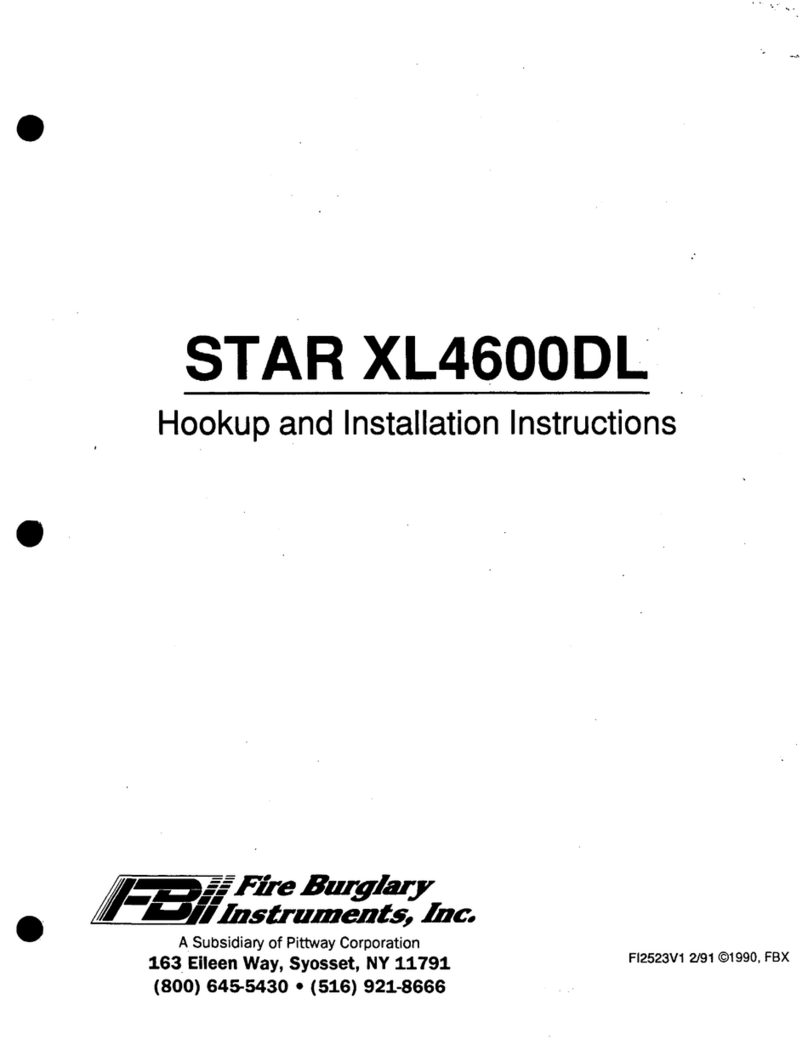
Fire Burglary Instruments
Fire Burglary Instruments STAR XL4600DL User manual
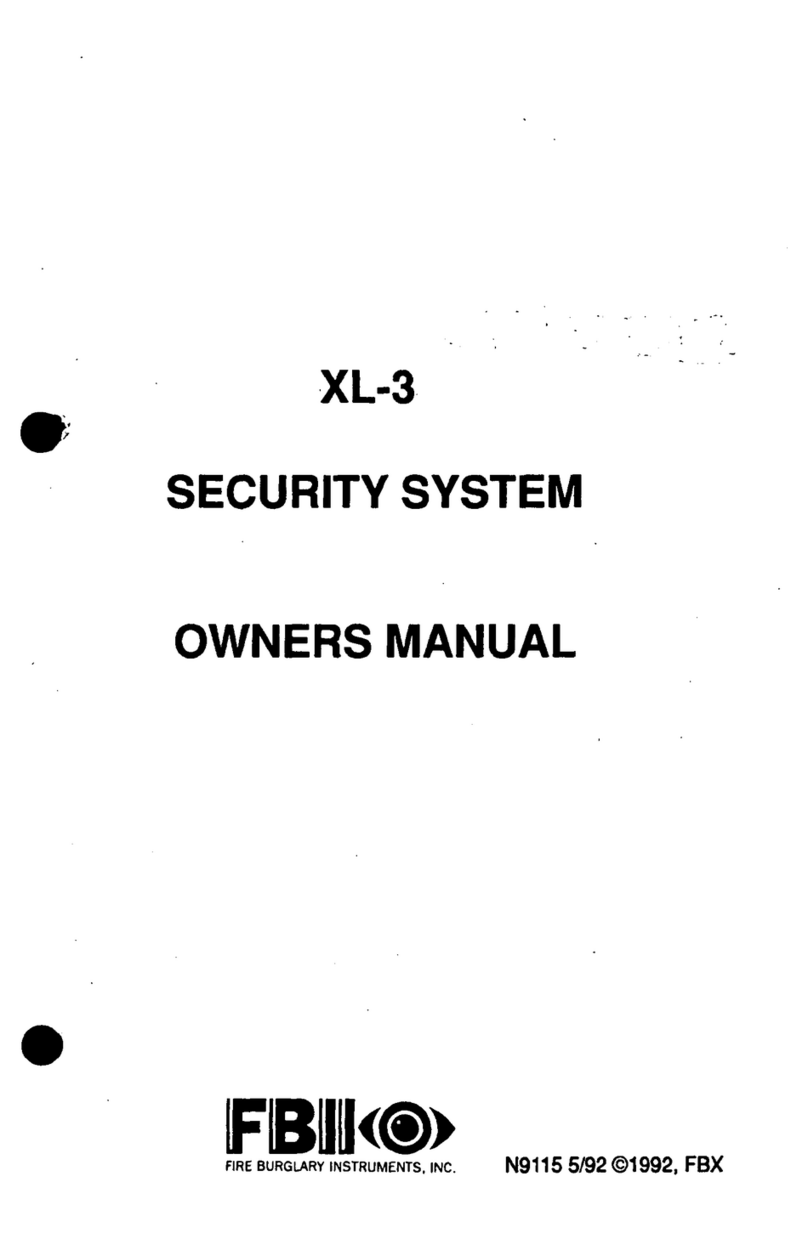
Fire Burglary Instruments
Fire Burglary Instruments XL-3 User manual

Fire Burglary Instruments
Fire Burglary Instruments LEGEND series User manual
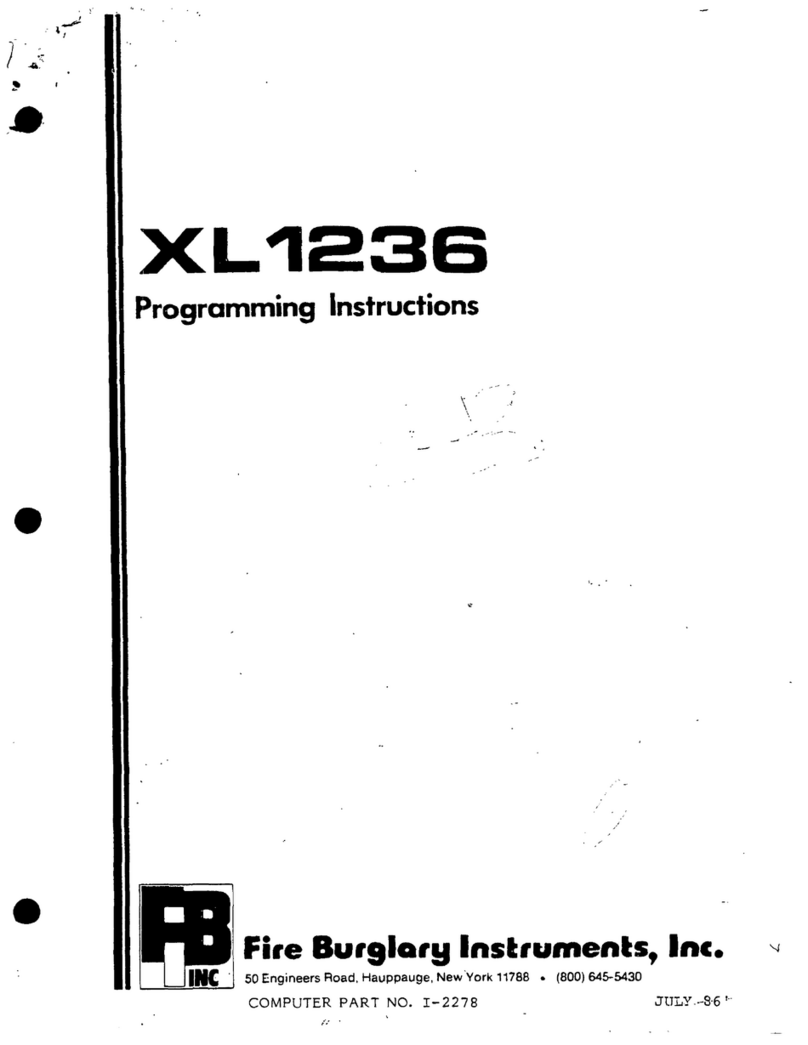
Fire Burglary Instruments
Fire Burglary Instruments XL1236 Installation manual
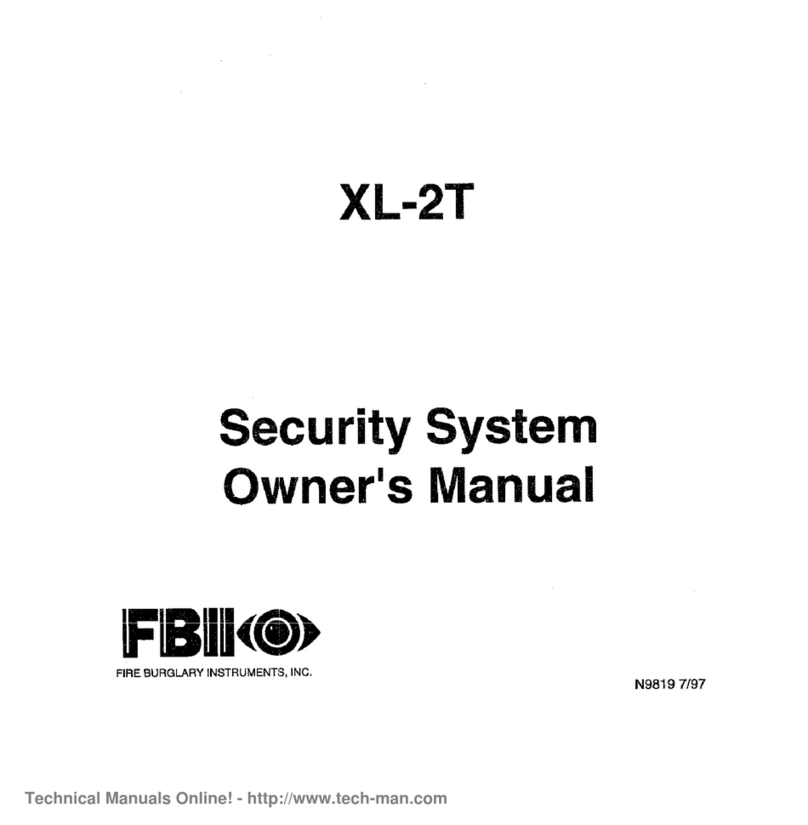
Fire Burglary Instruments
Fire Burglary Instruments XL-2T User manual
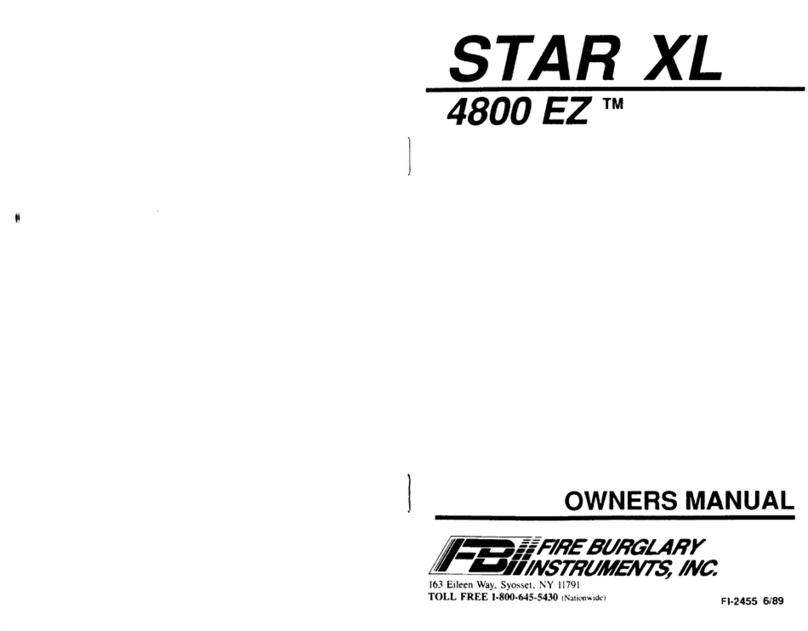
Fire Burglary Instruments
Fire Burglary Instruments Star XL 4800 EZ User manual


